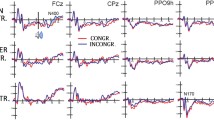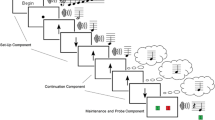Summary
(1) Slow brain potentials were recorded during musical tasks in 60 healthy subjects (42 right-handers and 18 left-handers). In period I the tasks (pitch comparison or distinguishing of chords) were solved and in period II the results were written down. Eye movements and vocalizations were avoided. (2) Unilateral lateralizations of negative potentials, recorded in transversal leads between corresponding brain regions, were determined from a baseline measured in a 3 s pretest period. Left-sided or right-sided lateralizations in frontal, precentral, parietal and temporal regions were taken as evidence for a stronger activation of the underlying cortical areas. (3) During period I, music tasks caused a right-sided lateralization in 53%, a left-sided one in 39% and no lateralization in 8% of the subjects. Language and calculation tasks, however, showed >80% left-sided lateralizations in the same subjects. In period II lateralizations appeared contralateral to the writing hand, mainly in pre-central leads. (4) The subjects (N = 60) were divided into 3 groups on the basis of their musical training: 20 non-musicians, 20 amateurs and 20 professional musicians were compared. A right-sided lateralization occurred more often in non-musicians and amateurs than in professionals. (5) Right-handers and left-handers had about equal right-sided lateralizations in musical tests. But in left-handers bilateral negativity without lateralization occurred more often and left-sided lateralization less often than in right-handers. (6) In 20 right-handers the passive experience or enjoyment of music was investigated. While only listening to music without tasks performance 8 subjects had a right-sided lateralization, 6 a left-sided one and 6 had bilateral negativity without lateralization. (7) We conclude that music processing, unlike language processing, is not dominant in one hemisphere. It is suggested that electrophysiological correlates of hemispheric lateralization during musical tests may depend on musical training and handedness, but statistical significance needs further investigations on more subjects.
Zusammenfassung
Von 60 gesunden Probanden (42 Rechtshänder und 18 Linkshänder) wurden langsame Hirnpotentiale bei Musikaufgaben in Periode I (Vergleich von Tonhöhen und Unterscheidung von Akkorden) und beim Schreiben der Ergebnisse in Periode II aufsummiert und gemittelt. (2) Einseitiges Überwiegen negativer Potentiale (Lateralisierung rechts oder links) wurde in Querableitungen zwischen korrespondierenden Hirnregionen frontal, präzentral, parietal and temporal links und rechts registriert. Die Lateralisierung wurde nach dem mittleren Potential einer Vorperiode von 3 s gemessen. Einseitige Lateralisierungen werden als hirnelektrische Korrelate vermehrter Aktivierung der darunter liegenden Rindenfelder gedeutet. (3) Bei Musikaufgaben der Periode I zeigten 53% der Probanden vorwiegende Rechtslateralisation, 39% Linkslateralisation und 8% keine Seitendifferenz. Sprach- und Rechenaufgaben machten bei den gleichen Probanden über 80% Linkslateralisation. In der Schreibperiode II war die Lateralisierung jeweils kontralateral zur schreibenden Hand und maximal über der motorischen Handregion. (4) Nach ihrer Musikausbildung wurden drei Gruppen unterschieden: 20 Musiklaien, 20 Musikamateure und 20 Berufsmusiker. Musiklaien und Musikamateure zeigten häufigere Rechtslateralisierung als Berufsmusiker. (5) Rechtshänder und Linkshänder hatten mit 51 und 56% etwa gleichhäufige Rechtslateralisation bei analytischen Musiktests. Doch waren bei den Linkshändern bilateral gleiche Potentiale häufiger und Linkslateralisation seltener als bei Rechtshändern. (6) Bei 20 Rechtshändern wurde das passive, gefühlsbetonte Musikhören ohne Testaufgabe untersucht. Dabei hatten nur 8 Probanden eine Rechtslateralisation, 6 eine Linkslateralisation und 6 keine Seitendifferenz. (7) Im Gegensatz zur Linksdominanz der Sprache ist Musikverarbeitung keine konstante Dominanzfunktion einer Großhirnseite. Es wird angenommen, daß die hirnelektrische Großhirnlateralisierung bei analytischen Musikaufgaben von der Musikausbildung und der Händigkeit beeinflußt werden kann. Doch sind die Unterschiede der drei Ausbildungsgruppen noch nicht statistisch signifikant und an grö\eren Probandenzahlen zu kontrollieren.
Similar content being viewed by others
Literatur
Altenmüller E, Jung R (1984) Electrophysiological evidence of hemispheric dominance for language, calculation and music. Pflügers Arch 400 (Suppl): R 49, R 194
Altenmuller E, Landwehrmeyer B, Jung R (1985) Electrophysiological evidence of right parietal dominance of visuo-spatial processing tasks. J Neurol 231 (Suppl): 140
Altenmuller E, Winker T, Jung R (1985) Hemispheric dominance for language and calculation in right-handers and left-handers. Pflügers Arch 405 (Suppl. 2) R 40, R 140
Benton AL (1977) The amusias. In: Critchley M, Henson RA (eds) Music and the brain. William Heinemann Medical Books Ltd, Londen, pp 378–397
Bever TG, Chiarello RJ (1974) Cerebral dominance in musicians and nonmusicians. Science 185:537–539
Borchgrevink H (1982) Prosody and musical rhythm are controlled by the speech hemisphere. In: Clynes M (ed) Music, Mind and Brain. The Neuropsychology of Music. Plenum, New York, pp 151–157
Brust JCM (1980) Music and language. Brain 103:367–392
Chiarenza GA, Papakostopoulos C, Giordano F, Guareschi-Cazzullo A (1983) Movement-related brain macro-potentials during skilled performance. A developmental study. Electroencephal Clin. Neurophysiol 56:373–383
Damasio AR, Damasio H (1977) Musical faculty and cerebral dominance. In: Music and the brain. Critchley M, Henson RA (eds) Heinemann Medical Books. London, Charles C. Thomas Springfield, Illinois, pp 141–155
Gordon HW (1978) Left hemispheric dominance for rhythmic elements in dichotically-based melodies. Cortex 14:58–70
Grünewald-Zuberbier E, Grünewald G (1978) Goal-directed movement potentials of human cerebral cortex. Exp Brain Res. 33:135–138
Grünewald-Zuberbier E, Grünewald G, Jung R (1978) Slow potentials of the human precentral and parietal cortex during goal-directed movements (Zielbewegungspotentiale). J Physiol 284:181–182 P
Grünewald G, Grünewald-Zuberbier E, Hömberg V, Netz J (1979) Cerebral potentials during smooth goal-directed hand movements in right-handed and left-handed subjects. Pflügers Arch 381:39–46
Henson RA (1977a) Neurological aspects of musical experience. In: Critchley M, Henson RA (eds) Music and the brain. William Heinemann Medical Books Ltd, London, pp 3–21
Henson RA (1977b) The language of music. In: Critchley M, Henson RA (eds) Music and the brain. William Heinemann Medical Books Ltd, Londen, pp 233–254
Henson RA (1985) Amusia. In: Frederiks JAM (ed). Handbook of clinical neurology. Vol 1, Elsevier Science Publishers, Amsterdam, pp 483–490
Hirshkowitz M, Earle J, Paley B (1978) EEG alpha asymmetry in musicians and nonmusicians: a study of hemispheric specialization. Neuropsychologia 16:125–128
Hjorth B (1975) An on-line transformation of EEG scalp potentials into orthogonal source derivations. Electroencephalogr. Clin Neurophysiol 39:526–530
Ingvar D (1983) Serial aspects of language and speech related to prefrontal cortical activity. A selective review. Human Neurobiol 2:177–189
Jung R (1984) Electrophysiological cues of the language-dominant hemisphere in man: slow brain potentials during language processing and writing. Exp Brain Res 9 (Suppl): 430–450
Jung R, Altenmüller E (1985) Hirnelektrische Korrelate der Großhirndominanz für Sprache, Rechnen und Musik. EEG-EMG 16:32
Jung R, Hufschmidt A, Moschallski W (1982) Langsame Hirnpotentiale beim Schreiben: Die Wechselwirkung von Schreibhand und Sprachdominanz bei Rechtshändern. Arch Psychiatr Nervenkr 232:305–324
Jung R, Altenmuller E, Natsch B (1984) Zur Hemisphärendominanz für Sprache und Rechnen: Elektrophysiologische Korrelate einer Linksdominanz bei Linkshändern. Neuropsychologia 22:755–775
Kleist K (1959) Sensorische Aphasien und Amusien auf myeloarchitektonischer Grundlage. Thieme, Stuttgart
Kornhuber HH, Deecke L (1965) Hirnpotentialänderungen bei Willkürbewegungen und passiven Bewegungen des Menschen: Bereitschaftspotential und reafferente Potentiale. Pflügers Arch ges Physiol 284:1–17
Landwehrmeyer B, Altenmüller E, Winker T (1985) Slow brain potentials as correlates of right hemispheric dominance during visual-spatial processing in man. Pflügers Arch 405 (Suppl. 2) R 40, R 139
Larsen B, Skinhoj E, Soh K (1977) The pattern of cortical activity provoked by listening and speech revealed by rCBF measurements. Acta Neurol Scand (Suppl) 64:268–269
Lashley KS (1951) The problem of serial order in behaviour. In: Jeffries LA (ed) Cerebral mechanisms in behaviour. Wiley, New York, pp 112–131
Levy J, Trevarthen C, Sperry RW (1972) Perception of bilateral chimeric figures following hemispheric deconnexion. Brain 95:61–78
MacKay DM (1983) On-line source-density computation with a minimum of electrodes. Electroencephalogr. Clin Neurophysiol 56:696–698
Mazziotta J, Phelps M, Carson R, Kuhl D (1982) Tomographic mapping of human cerebral metabolism: Auditory stimulation. Neurology (NY) 32:921–937
Roland PE, Larsen B, Skinhøj E, Lassen NA (1977) Regional cerebral blood flow increases due to treatment of somatosensory and auditive information in man. Acta Neurol Scand (Suppl) 64:540–541
Roland PE, Skinhøj E, Lassen NA (1981) Focal activations of the human cerebral cortex during auditory discrimination. J Neurophysiol 45:374–386
Sidtis J (1980) On the nature of cortical function underlying right hemisphere auditory perception. Neuropsychologia 18:321–330
Sidtis J (1984) Music, pitch perception and the mechanisms of cortical hearing. In: Gazzaniga M (ed) Handbook of cognitive neuroscience. Plenum, New York, pp 91–114
Sperry RW (1974) Lateral specialization in the surgically separated hemispheres. In: The neurosciences, third study program. Schmitt FO, Wordon FG (eds) MIT-Press, Cambridge A. pp 5–19
Sperry RW, Gazzaniga MS, Bogen JE (1969) Interhemispheric relationship: the neocortical commisures: syndromes of hemisphere disconnection. In: Vinken PJ, Bruyn GW (eds) Handbook of clinical neurology. Elsevier, Amsterdam, pp 273–290
Sutton S, Braren M, Zubin J (1965) Evoked potential correlates of stimulus uncertainty. Science 150:1187–1188
Sutton S, Braren M, Zubin J, John ER (1967) Information delivery and the sensory evoked potential. Science 155:1436–1439
Tönnies JF (1934) Die unipolare Ableitung elektrischer Spannungen vom menschlichen Gehirn. Naturwissenschaften 22:411–414
Walter WG (1964) Slow potential waves in the human brain associated with expectancy, attention and decision. Arch Psychiatr Nervenkr 206:309–322
Wertheim N (1969) The Amusias. In: Vinken PJ, Bruyn GW (eds) Handbook of clinical neurology, vol 4, North-Holland Publishing Co Amsterdam, pp 195–206
Author information
Authors and Affiliations
Rights and permissions
About this article
Cite this article
Altenmüller, E. Hirnelektrische korrelate der cerebralen musikverarbeitung beim menschen. Eur Arch Psychiatr Neurol Sci 235, 342–354 (1986). https://doi.org/10.1007/BF00381003
Received:
Issue Date:
DOI: https://doi.org/10.1007/BF00381003




